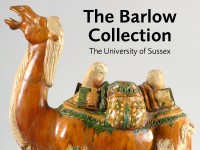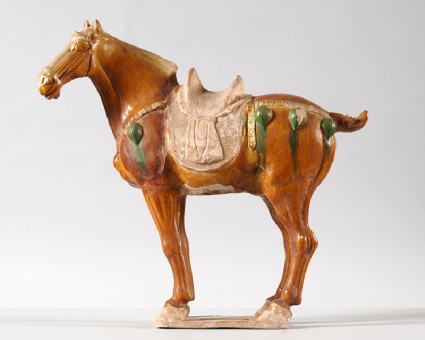The Barlow Collection
A select catalogue of the Barlow collection of Chinese Ceramics, Bronzes and Jades by the University of Sussex (published Sussex, 2006).

Publications online: 456 objects
Figure of a horse with saddle
- loan
-
Literature notes
Standing on a rectangular plinth, the horse has a massive neck and an elegant head, slightly turned to the left, the features well rendered, with long curled fringes, angular, cropped mane, and tied-up tail. The body is naturalistically modelled, the harness straps adorned with square florets and hung with tassels and probably a bell in front, the saddle placed over an oval blanket and draped with a cloth which is tied together on either side. The horse is glazed in sancai (‘three colours’), with a deep amber-brown predominating, with white blaze, mane, tail and harness, green tassels and amber-yellow bell, while the saddle and saddle blankets were left unglazed and show traces of pigment. The earthenware body is of light beige colour. -
Details
- Associated place
-
Asia › China › Henan province (place of creation)
- Date
-
7th - 8th century AD (AD 601 - 800)
Tang Dynasty (AD 618 - 907)
- Material and technique
- earthenware, moulded and luted together, and with sancai glaze; saddle, with traces of pigment
- Dimensions
- 50 x 52.2 x 17.5 cm (height x width x depth)
- Material index
- Technique index
-
- Object type index
- No. of items
- 1
- Credit line
- Lent by the Sir Alan Barlow Collection Trust.
- Accession no.
- LI1301.400
-
Further reading
University of Sussex, and Arts and Humanities Research Council, The Barlow Collection, supervised by Regina Krahl, Maurice Howard, and Aiden Leeves (Sussex: University of Sussex, 2006), no. S7
Glossary (3)
earthenware, glaze, luted
-
earthenware
Ceramic material made of clay which is fired to a temperature of c.1000-1200⁰c. The resulting ceramic is non-vitreous and varies in colour from dark red to yellow.
-
glaze
Vitreous coating applied to the surface of a ceramic to make it impermeable or for decorative effect.
-
luted
The fusion of parts of ceramics using dilute clay slip.
Location
-
- currently in research collection
Objects are sometimes moved to a different location. Our object location data is usually updated on a monthly basis. Contact the Jameel Study Centre if you are planning to visit the museum to see a particular object on display, or would like to arrange an appointment to see an object in our reserve collections.
Publications online
-

The Barlow Collection
Standing on a rectangular plinth, the horse has a massive neck and an elegant head, slightly turned to the left, the features well rendered, with long curled fringes, angular, cropped mane, and tied-up tail. The body is naturalistically modelled, the harness straps adorned with square florets and hung with tassels and probably a bell in front, the saddle placed over an oval blanket and draped with a cloth which is tied together on either side. The horse is glazed in sancai (‘three colours’), with a deep amber-brown predominating, with white blaze, mane, tail and harness, green tassels and amber-yellow bell, while the saddle and saddle blankets were left unglazed and show traces of pigment. The earthenware body is of light beige colour.
Notice
Object information may not accurately reflect the actual contents of the original publication, since our online objects contain current information held in our collections database. Click on 'buy this publication' to purchase printed versions of our online publications, where available, or contact the Jameel Study Centre to arrange access to books on our collections that are now out of print.
© 2013 University of Oxford - Ashmolean Museum









